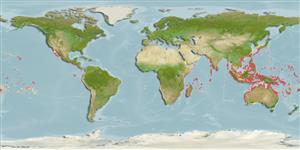>
Perciformes/Scorpaenoidei (Scorpionfishes) >
Scorpaenidae (Scorpionfishes or rockfishes) > Scorpaeninae
Etymology: Parascorpaena: Greek, para = near, in the side + Latin, scorpaena = a kind of fish, 1706 (Ref. 45335).
More on author: Peters.
Issue
Distribution of this species probably include those referring to Parascorpaena armata. Please send references.
Environment: milieu / climate zone / depth range / distribution range
Ecología
marino asociado a arrecife; rango de profundidad 0 - 18 m (Ref. 9710). Tropical
Indo-Pacific: East Africa to the Society Islands, north to Izu Islands, south to Australia; throughout Micronesia (Ref. 1602). Specimens from the Pacific Ocean, currently
regarded as P. mossambica, are most likely to be P. armata (H. Motomura, unpubl. data). The name, P. mossambica., remains valid for specimens from the Indian Ocean (Ref. 86966).
Tamaño / Peso / Age
Maturity: Lm ? range ? - ? cm
Max length : 12.0 cm TL macho / no sexado; (Ref. 90102)
Espinas dorsales (total) : 12; Radios blandos dorsales (total) : 9; Espinas anales: 3; Radios blandos anales: 5. Supraocular tentacles well developed (Ref. 37816, 48635).
Inhabits areas with mixed sand and rubble in reef flats, shallow lagoons, and channels. Hides during the day, ventures out in the open at night. Anterolateral glandular groove with venom gland (Ref. 57406). Solitary (Ref 90102).
Life cycle and mating behavior
Madurez | Reproducción | Puesta | Huevos | Fecundidad | Larva
Myers, R.F., 1991. Micronesian reef fishes. Second Ed. Coral Graphics, Barrigada, Guam. 298 p. (Ref. 1602)
IUCN Red List Status (Ref. 130435: Version 2024-1)
Human uses
Pesquerías: de interés potencial
Herramientas
Special reports
Download XML
Fuentes de Internet
Estimates based on models
Preferred temperature (Ref.
123201): 24.3 - 29.3, mean 28.4 °C (based on 2873 cells).
Phylogenetic diversity index (Ref.
82804): PD
50 = 0.5078 [Uniqueness, from 0.5 = low to 2.0 = high].
Bayesian length-weight: a=0.01288 (0.00620 - 0.02676), b=3.03 (2.86 - 3.20), in cm total length, based on LWR estimates for this (Sub)family-body shape (Ref.
93245).
Nivel trófico (Ref.
69278): 3.6 ±0.6 se; based on size and trophs of closest relatives
Resiliencia (Ref.
120179): Alto, población duplicada en un tiempo mínimo inferior a 15 meses (Preliminary K or Fecundity.).
Fishing Vulnerability (Ref.
59153): Low vulnerability (10 of 100).
Nutrients (Ref.
124155): Calcium = 101 [51, 235] mg/100g; Iron = 0.734 [0.366, 1.961] mg/100g; Protein = 18.2 [16.3, 20.2] %; Omega3 = 0.226 [0.095, 0.624] g/100g; Selenium = 20 [10, 51] μg/100g; VitaminA = 183 [60, 527] μg/100g; Zinc = 1.63 [1.09, 2.40] mg/100g (wet weight);
